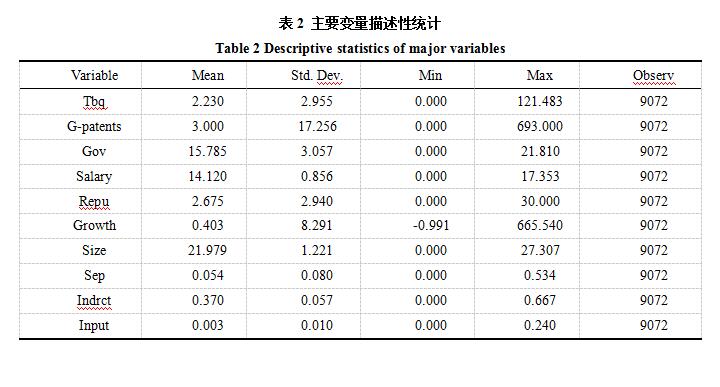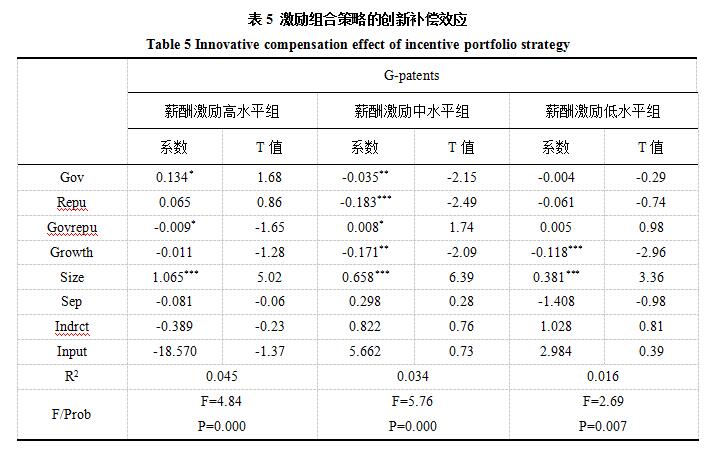责任编辑:牛乐耕
王旭 王非
摘要:绿色创新已成为驱动中国制造业转型的重要路径。过度依赖科技政策的外生冲击而忽略企业内生激励机制,容易造成创新平滑失效和公共资源的配置扭曲。本文从财税政策与公司治理双重层面,重点探讨政府补贴与高管激励对企业绿色创新的整合影响。研究显示,薪酬激励的创新补偿效应能够提升财税补贴政策对企业绿色创新的平滑效果;相比之下,声誉激励对财税补贴与绿色创新关系的影响并不显著;薪酬激励与声誉激励的互补关系催生了激励组合的创新补偿效应,在薪酬激励强度适中的条件下,财税补贴能够实现对绿色创新的最优驱动作用。本文能够从公司治理视角揭示财税补贴创新悖论的成因,并为优化政府财税政策和企业创新激励机制,推动中国制造业绿色发展提供科学依据。
关键词:政府补贴;绿色创新;薪酬激励;声誉激励
1引言
中国制造业转型升级背景下,绿色创新已成为促进企业经济与生态环境协调发展,实现制造业绿色发展的重要途径[1]。为缓解企业面临的创新融资约束,国家与地方政府开始着力通过财税政策来支持企业绿色创新。然而,政府财税政策的创新平滑效应受到了学术界的质疑。“杠杆效应”假说认为,财税补贴以及政府围绕财税资源制定的审核与评估机制,有利于企业提升研发投入和创新绩效[2]。并且,财税补贴的“信号传递”与“认证效应”提高了企业在资本市场中的融资能力,可以间接补充创新资源[3,4]。但也有文献指出,大量政府补贴的涌入会降低企业家的冒险精神,抑制创新绩效[5,6]。另外,地方政府的“晋升锦标赛”容易造成企业骗补、寻租等行为,导致政策失灵以及公共资源浪费[7,8]。
创新绩效的产出不仅依赖于企业的资源禀赋状态,更受到管理层决策意愿和资源配置效率的影响。因此,仅仅依靠财税政策来解决“无米下锅”的问题并不足以从根本上提升企业创新绩效。信息不对称条件下,高管更倾向于利用有限的资源开展私利挖掘,而非风险较高的创新活动[9]。并且,高管比股东承担了更多的创新风险,而创新收益则大部分被股东占据。创新补偿的缺失进一步挫伤了高管创新意愿[10]。作为重要的公司治理机制,高管激励不仅能够有效降低委托代理成本,还能够通过提供创新补偿收益的方式激发高管创新意愿,因而构成了高管与企业激励相容的重要条件。那么,对于具有货币效用的薪酬激励和具有心理效用的声誉激励[11,12,13],何种激励策略更有利于激发高管的绿色创新意愿,提高对政府补贴的配置效率?
本文重点探讨了政府补贴对绿色创新的平滑效果,并在分析薪酬激励、声誉激励以及激励组合策略的创新补偿效应的基础上,阐释不同激励策略对财税补贴创新平滑效应的差异化影响。本文的边际贡献体现在:第一,聚焦于绿色创新这一独特创新形式,在分析其价值创造效应的基础上,揭示政府补贴对绿色创新的影响,突破了已有文献对创新形式进行泛化处理而造成的研究困境。第二,从创新补偿视角,基于薪酬激励与声誉激励双重层面考察政府补贴推动绿色创新的实现条件,对财税补贴的创新悖论进行全新解释。第三,全面考虑高管面临的真实决策情境,分析激励组合策略的创新补偿效应,为提升政府补贴对绿色创新的平滑效果提供更为丰富的管理层激励方案。
2研究设计
2.1研究假设
2.1.1政府补贴与企业绿色创新
绿色创新是以提高能源利用效率和节能减排为途径,以实现企业经济与生态环境和谐发展为目标的创新活动[14]。企业不仅能通过绿色工艺创新降低经济成本和环境外部性[15],还可以利用绿色产品的研发来提高企业财务绩效与竞争优势[16]。绿色创新对企业经济与生态环境的双重价值效应[17],能够满足地方政府对生态经济和谐发展的决策目标,使其具有充分的动机将公共资源投向企业绿色创新活动。2016年,中国国务院发改委、环保部等部门联合印发了《绿色发展指标体系》和《生态文明建设考核目标体系》,将绿色发展指标纳入政府考核内容,激发了地方政府利用财税政策来支持企业绿色创新活动的主观意愿。
然而,由于信息不对称和委托代理问题的存在,高管或会利用创新“噱头”来捕获政府补贴等外部资源,以满足个人私利[18,19]。尤其在政府广泛运用财税政策大力推进企业绿色创新的背景下,绿色创新很可能沦为高管追逐私利的个人工具[20]。由此,财税政策能够驱动企业绿色创新的前提条件在于,内生于企业的公司治理机制能否实现高管个人目标函数与企业长期价值的统一。事实上,尽管绿色创新对竞争优势和环境绩效均具有价值创造作用,但二者难以在短期内转变为企业可观测绩效。并且,作为创新风险的主要承担者,高管无法获取所有的创新收益,这便需要企业设计和运用高管激励机制以对其个人收益进行补偿。
2.1.2薪酬与声誉激励的创新补偿
高管薪酬是高管向公司支付个人脑力或体力劳动的经济所得,是利用专业经验、技术、能力向公司换取的货币收益。在薪酬激励的影响下,高管不仅可以通过履行勤勉义务,制定科学有效的经营决策[21],还可以迫使高管打破对原有技术的低端锁定状态,尝试通过创新变革来完成绩效目标。对绿色创新而言,高管一方面能够通过绿色产品创新来提高市场绩效,另一方面能利用工艺创新来降低生态成本和外部规制,重塑经营合法性。尤其当企业获得财税补贴的资助后,绿色创新有利于高管顺利达成政府对环境绩效的考核目标,以及薪酬激励契约所规定的绩效目标,进而获得个人的创新补偿。
“声誉”产生的心理满足感、社会认同感和个人成就感等心理效用成为了激发高管努力工作的直接诱因[13,22]。但对绿色创新而言,声誉激励带来的创新补偿效应十分有限。在产品创新层面,企业的诉求主要体现在其经济价值贡献上,社会公众并不会因产品的绿色功能属性而对企业产生额外的声誉评价。在工艺创新层面,虽然绿色工艺创新能够降低环境外部性,但企业利益相关者会将高管在绿色工艺创新过程中付诸的努力视为一种“理所应当”,是企业获取经济利益的必要成本,而非能够增加社会整体福利水平的独特贡献。其次,绿色工艺创新无法在短时间内转化为经济价值,甚至会挤占产品的研发投入,降低了市场的积极预期。因此社会公众难以对高管声誉产生“显性”积累。基于以上分析,本文提出假设:
H1a:薪酬激励具有较强的创新补偿效应。薪酬激励越强,政府补贴对绿色创新的积极影响越显著。
H1b:声誉激励缺乏创新补偿效应。声誉激励在政府补贴与绿色创新关系中的调节作用不显著。
2.1.3激励组合策略的创新补偿
在企业真实决策情境中,高管通常会受到多种激励机制的整合影响。从激励期限结构来看,薪酬激励属于中短期激励机制,而声誉激励属于长期激励机制。从激励原理分析,薪酬激励属于经济效用诱导下的激励机制,具有货币性和契约性,而声誉激励属于心理效用诱导下的激励机制,具有非货币性和非制度性。由此可见,二者存在典型的互补关系。
相较于声誉带来的心理满足感和成就感等非货币效用,货币效用在高管心理诉求层次上占据优先地位。高管需要在满足对货币效用诉求的条件下,才会追逐由声誉激励带来的心理效用。随着薪酬激励强度的改变,激励组合策略的创新补偿效应将发生动态演进。当薪酬激励强度较低时,激励组合策略无法产生有效的创新补偿。由于绿色创新风险分布于产品研发、生产和市场调整等多个环节,需要较高的货币收益来补偿高管的风险承担。单一的声誉激励机制无法弥补低薪酬水平带来的激励损失,创新补偿效应十分微弱。随着薪酬激励强度的提升,高管获得的经济收益增加,并会因货币效用的不断满足转而追求声誉带来的心理满足感与成就感。此时,两类激励机制的组合作用将产生较强的创新补偿。而当薪酬激励处于较高水平时,高管或因难以达到契约规定的激励条件而开展保守型投资决策,甚至重回低端锁定状态。且在货币收益不足且声誉激励补偿效应有限的条件下,声誉带来的心理效用难以激发企业创新意愿。激励组合的创新补偿效应再次下降。基于以上分析,本文提出以下假设:
H2a:当薪酬激励处于适中水平时,绿色创新补偿效应将随着声誉激励的增强而增强,政府补贴对绿色创新的促进效应不断提升。
H2b:当薪酬激励处于较高或较低水平时,声誉激励的变化将不会对绿色创新补偿效应产生显著影响。
2.2样本选取与数据来源
本文选取在沪深两市上市的制造业企业为研究样本。2010年,中国工信部工作会议指出,要制定专项规划和产业政策对先进制造业进行研发支持。所以,本文将时间观测窗口设为2010-2017年。在剔除未连续经营的、变量数据严重缺失以及ST类的样本后,获取了1134家上市公司的数据,构建了观测值为9072的平衡面板数据库。其中,绿色发明、实用新型和外观设计专利由笔者在中国专利全文数据库手工收集所得。声誉激励变量数据由笔者根据上市公司历年高管简历进行筛选和整理所得。其他数据均来源于国泰安上市公司数据库。

2.3.1绿色创新
已有文献多采用工业废气排放量[23]或者单位能耗的新产品销售收入来测量绿色创新[24]。本文认为尽管已有测量方法考虑到了产业层面的能耗和污染排放问题,但无法在微观视角下观测企业之间绿色创新的差异。为克服已有研究局限,并考虑到专利授权容易受到技术以外的其他因素的影响,本文结合文本分析和关键词抓取方法,利用绿色专利申请量来衡量绿色创新。首先,根据Rennings[25]、Kemp[15]等权威文献对“绿色创新”、“环境创新”、“生态创新”相关概念的界定,抓取能够反映绿色创新核心意涵的关键词。通过中英文双向互译,构建了包括环保、节能、低碳等10个关键词的词表。然后,以样本公司在观测期内历年申请的专利全文作为文本分析对象,初步筛选出包含关键词的发明专利、实用新型专利和外观设计专利。最后,对绿色专利进行人工筛查,剔除包含关键词但不属于绿色创新范畴的专利数据,以提高测量精度。
2.3.2高管激励
声誉激励方面,考虑到高管声誉塑造途径的多元性,本文从政治声誉、社会声誉以及专业技术声誉三个方面来衡量声誉激励水平。其中,政治声誉是政治权利与政治影响力对管理层产生的激励作用。本文采用当期企业高管团队中,曾任或现任政府部门官员的高管数量与具有“人大代表”、“政协委员”身份的人员总数进行测量。社会声誉反映了高管在所属行业中的认可度和社会影响力。利用在行业协会以及相关理事会等组织中具有兼职的高管人员总数进行测量。专业技术声誉主要刻画了高管在专业技术领域中取得的成就和影响力,采用当期获得“科技创新奖”、“五一劳动奖章”等专业技术性奖励或荣誉的高管人员总数进行测量。
2.3.3政府补贴与其他变量
本文利用当期政府补贴总额的自然对数衡量政府补贴[7]。企业绩效方面,选取更能全面反映企业的市场价值和财务绩效的托宾Q值进行测量[26]。控制变量方面,本文将治理特征变量与公司特征变量纳入控制变量组,其中,治理特征变量包括:两权分离度、独立董事比例。公司特征变量包括:公司成长性、公司规模、R&D投入。具体变量解释见表1。

3实证结果分析

表2为主要变量的描述性统计结果。绿色创新专利申请数量最大值为693,最小值为0,标准差为17.256。表明不同的制造业企业在绿色创新意愿和创新产出方面具有较大差异。政府补贴最大值为21.810,最小值为0,标准差为3.057。表明地方政府的财税补贴的筛选机制较为严格,企业获取的政府补贴数额差异较大。相较于声誉激励,薪酬激励变量波动性较小,标准差为0.856,最大值为17.353,最小值为0。表明样本公司普遍重视对高管的薪酬激励作用。声誉激励变量最大值为30,最小值为0,表明样本公司的声誉激励强度差异较大。
3.2政府补贴对绿色创新的影响

表3报告了绿色创新的价值效应及政府补贴对绿色创新的影响分析结果。模型M1中,绿色创新变量的回归系数为0.008,且通过了0.1水平的显著性检验。该结果表明绿色创新有利于提升企业整体绩效,具有显著的价值创造效应。M2中,解释变量绿色创新的回归系数0.055,显著性水平为0.05。表明政府补贴与绿色创新具有显著的积极变动关系。结合以上回归结果分析,企业绿色创新的双重价值效应契合了地方政府对区域经济和生态保护的双重预期。政府补贴可以有效弥补绿色创新由于知识溢出和技术溢出造成的减损,并能在资本市场中发挥“认证效应”缓解企业融资约束,促进绿色创新绩效。
3.3薪酬与声誉激励的补偿效应

表4报告了薪酬激励与声誉激励对政府补贴与绿色创新关系的差异化影响检验结果。在M3a中,薪酬激励与政府补贴的交互项回归系数为0.009,显著性水平为0.1。表明薪酬激励表现出显著的创新补偿效应。绿色创新不仅能提高能耗效率,实现成本“节流”,还能提升市场绩效,促进利润“开源”,因此有利于高管达成绩效目标。更重要的,薪酬激励产生的创新补偿有效弥补了高管的风险承担与收益获取的匹配性失衡。因此高管具有充分的动机将获取的财税补贴投入到绿色创新活动中,以实现个人收益与组织收益的共赢。在模型M3b中,声誉激励与政府补贴的交互项回归系数为0.004,T统计量仅为0.600。表明声誉激励无法发挥有效的创新补偿效应。社会公众对企业绿色创新战略的归因倾向导致高管声誉无法获得有效积累。并且绿色工艺创新的对经济绩效的贡献需要转换时间,这可能挤出绿色产品创新所必需的资源投入,降低了公众与市场对产品的积极评价,较大程度上降低了声誉对高管绿色创新意愿的激励作用。假设H1a、H1b得证。
3.4激励组合策略的补偿效应

表5报告了薪酬激励、声誉激励的组合策略对高管绿色创新补偿效应的检验结果。在低薪酬激励组中,声誉激励与政府补贴的交互项系数为0.005,但未通过显著性检验。表明薪酬激励水平过低时,激励组合策略对政府补贴与绿色创新的关系影响不显著,创新补偿效应较弱。由于薪酬激励产生的货币效用比声誉激励产生的非货币效用有更高的优先级,管理层在无法获得薪酬激励带来的货币补偿的条件下,创新意愿无法被激励组合有效激发。而在中薪酬激励组中,声誉激励与政府补贴的交互项为0.008,显著性水平为0.1。薪酬激励强度的提升增加了对高管创新风险承担的货币补偿,且高管开始关注声誉带来的非货币效用,二类激励机制开始发挥互补作用。在高薪酬激励组中,声誉激励与政府补贴的交互项系数为-0.009,且通过了0.1水平的显著性检验。表明薪酬激励水平过高时,声誉激励在政府补贴与绿色创新关系中起到了负向调节作用。薪酬契约规定绩效目标的完成难度较大,此时高管更倾向于将政府补贴等战略资源配置到变现期限较短的投资活动中,从而不仅挤出了绿色创新必要的资金投入,而且容易使高管进入低端锁定状态,最终抑制了绿色创新绩效。假设H2a、H2b得证。
4研究结论与启示
绿色创新的双重价值效应对中国制造业企业绿色发展具有重要意义,而政府的财税政策是否真正发挥了对企业绿色创新的平滑作用仍存在争议。本文重点探讨了薪酬激励、声誉激励与激励组合策略对政府补贴与绿色创新关系的影响。研究显示:
第一,薪酬激励具有显著的创新补偿效应,能够有效提升政府补贴对绿色创新的积极影响。绿色创新的双重价值效应是高管实现薪酬激励契约目标的重要途径,而薪酬激励所提供的货币补偿不仅能够改善高管的创新风险承担与创新收益获取的失衡问题,而且能够有效提升高管对政府补贴等创新资源的配置效率。第二,声誉激励的创新补偿效应不显著,未能提升政府补贴对绿色创新的平滑效应。由于社会公众及利益相关者倾向于将绿色创新活动归因于企业为获取利润或降低规制压力而被迫采取的创新决策,因此高管无法通过绿色创新来获得声誉累积。第三,薪酬与声誉激励组合的创新补偿效应依赖于薪酬激励的强弱程度。薪酬激励过低会导致高管因无法获得充分的货币补偿而放弃绿色创新活动,薪酬激励强度过高容易导致创新挤出,形成低端锁定。仅当薪酬激励强度适中时,薪酬与声誉激励才能发挥有效的互补效用,提升高管对政府补贴等创新资源的配置效率。
本文对于优化制造业企业创新激励机制和提升财税政策对绿色创新的平滑作用具有重要政策启示。首先,应加强地方政府对补贴企业的监督和评估机制,降低财税政策对公司内部治理环境的依赖性。地方政府应一方面建立基于补贴申请和使用流程的动态监管机制,另一方面应将企业绿色创新绩效纳入评价体系,切实提高企业对财税补贴的配置效率。再者,优化高管激励契约,强化治理机制的绿色创新激励效应。将绿色创新绩效作为目标绩效引入高管薪酬激励契约,深入改善高管风险承担与收益获取的失衡问题。要深入完善高管在经理人市场中的声誉评价体系,将高管对绿色创新活动的贡献度作为评价指标,加强声誉激励对绿色创新的驱动作用。最后,发挥高管激励机制之间的协同效应,提升对高管的绿色创新补偿。企业应一方面权变设定薪酬激励契约中的业绩考核目标,避免因目标实现难度过大或过小而造成的激励失效。另一方面通过对公众与利益相关者的宣传与引导,改变其对企业绿色创新的归因倾向,提高声誉激励机制的创新补偿效应。
参考文献:
Ghisetti C, Rennings K. Environmental innovations and profitability: How does it pay to be green? An empirical analysis on the German innovation survey[J]. Journal of Cleaner Production, 2014, 75(14):106-117.
Kleer R. Government R&D subsidies as a signal for private investors[J]. Research Policy, 2010, 39(10):1361-1374.
Feldman M P, Kelley M R. The ex ante assessment of knowledge spillovers: Government R&D policy, economic incentives and private firm behavior[J]. Research Policy, 2006, 35(10):1509-1521.
Takalo T, Tanayama T. Adverse selection and financing of innovation: Is there a need for R&D subsidies?[J]. Journal of Technology Transfer, 2010, 35(1):16-41.
Wallsten S J. The effects of government-industry R&D programs on private R&D: The case of the small business innovation research program[J]. Rand Journal of Economics, 2000, 31(1):82-100.
Duguet E. Are R&D subsidies a substitute or a complement to privately funded R&D? Evidence from France using propensity score methods for non-experimental data[J]. Social Science Electronic Publishing, 2003, 114(411007):245.
赵璨, 王竹泉, 杨德明, 曹伟. 企业迎合行为与政府补贴绩效研究——基于企业不同盈利状况的分析[J]. 中国工业经济, 2015(7):130-145.
Zhao Can, Wang Zhu-quan, Yang De-ming, Cao Wei. Research on the catering behavior of enterprise and government subsidy performance: Based on the analysis of the enterprise’s profitability[J]. China Industrial Economics, 2015(7):130-145.
武咸云, 陈艳, 杨卫华. 战略性新兴产业的政府补贴与企业R&D投入[J]. 科研管理, 2016, 37(5):19-23.
Wu Xianyun, Chen Yan, Yang Weihua. A research on the effect of government subsidies on R&D investment of strategic emerging industries[J]. Science Research Management, 2016, 37(5):19-23.
Wright M, Hoskisson R E, Busenitz L W. Firm rebirth: Buyouts as facilitators of strategic growth and entrepreneurship[J]. The Academy of Management Executive (1993-2005), 2001, 15(1):111-125.
Low A. Managerial risk-taking behavior and equity-based compensation[J]. Working Paper, 2006, 92(3):470-490.
陈修德, 梁彤缨, 雷鹏, 秦全德. 高管薪酬激励对企业研发效率的影响效应研究[J]. 科研管理, 2015, 36(9):26-35.
Chen Xiude, Liang Tongying, Lei Peng, Qin Quande. Influence of executive compensation incentives on corporate R&D efficiency[J]. Science Research Management, 2015, 36(9):26-35.
Dale-Olsen H. Executive pay determination and firm performance: Empirical evidence from a compressed wage environment[J]. The Manchester School, 2012, 80(3):355-376.
王旭, 徐向艺. 基于企业生命周期的高管激励契约最优动态配置——价值分配的视角[J]. 经济理论与经济管理, 2015, 35(6):80-93.
Wang Xu, Xu Xiangyi. The optimal dynamic collocation of senior executives’ incentive contracts: An empirical study based on enterprise lifecycle theory[J]. Economic Theory and Business Management, 2015, 35(6):80-93.
Jaffe A B, Palmer K. Environmental regulation and innovation: A panel data study[J]. Review of Economics & Statistics, 1997, 79(4):610-619.
Kemp R. Eco-innovation: Definition, measurement and open research issues[J]. Economia Politica, 2010, 27(3):397-420.
Driessen P H, Hillebrand B, Kok R A W, Verhallen T M M. Green new product development: The pivotal role of product greenness[J]. IEEE Transactions on Engineering Management, 2013, 60(2):315-326.
Sharma S, Vredenburg H. Proactive corporate environmental strategy and the development of competitively valuable organizational capabilities[J]. Strategic Management Journal, 1998, 19(8):729-753.
Hall B H, Harhoff D. Recent research on the economics of patents[J]. Annual Review of Economics, 2012, 4(1):541-565.
Tong T W, He W, He Z L, et al. Patent regime shift and firm innovation: Evidence from the second amendment to China's patent law[J]. Academy of Management Annual Meeting Proceedings, 2014(1):14174.
王旭, 杨有德. 企业绿色技术创新的动态演进:资源捕获还是价值创造[J]. 财经科学, 2018(12):53-66.
Wang Xu, Yang Youde. Dynamic evolution of business green technological innovation: Resource capturing or value creation[J]. Finance & Economics, 2018(12):53-66.
Lazear E P, Rosen S. Rank-order tournaments as optimum labor contracts[J]. Social Science Electronic Publishing, 1981, 89(5):841-64.
宁向东, 崔弼洙, 张颖. 基于声誉的独立董事行为研究[J]. 清华大学学报(哲学社会科学版), 2012(1):129-136.
Ning Xiangdong, Cui Bizhu, Zhang Ying. Research on the behavior of independent directors based on reputation[J]. Journal of Tsinghua University (Philosophy and Social Sciences), 2012(1):129-136.
张江雪, 朱磊. 基于绿色增长的我国各地区工业企业技术创新效率研究[J]. 数量经济技术经济研究, 2012(2):113-125.
Zhang Jiangxue, Zhu Lei. Research on technological innovation efficiency of industrial enterprises based on green growth on regions in China[J]. The Journal of Quantitative & Technical Economics, 2012(2):113-125.
王锋正, 姜涛, 郭晓川. 政府质量、环境规制与企业绿色创新[J]. 科研管理, 2018, 39(1):26-33.
Wang Fengzheng, Jiang Tao, Guo Xiaochuan. Government quality, environmental regulation and green technological innovation of enterprises[J]. Science Research Management, 2018, 39(1):26-33.
Rennings K. Towards a theory and policy of eco-innovation-neoclassical and (co-)evolutionary perspectives[J]. Zew Discussion Papers, 1998, 35(1):23–32.
姚冰湜, 马琳, 王雪莉, 李秉祥. 高管团队职能异质性对企业绩效的影响:CEO权力的调节作用[J]. 中国软科学, 2015(2):117-126.
Yao Bingshi, Ma Lin, Wang Xueli, Li Bingxiang. Functional diversity in top management team and firm performance: The moderating role of CEO power[J]. China Soft Science, 2015(2):117-126.
No resource or no motivation? Government subsidies, green innovation and incentive strategy selection
Wang Xu, Wang Fei
(Business Administration School, Shandong University of Finance and Economics, Jinan 250014, Shandong, China)
Abstract:With the overloading development of natural resources and the emergence of environmental problems, Chinese manufacturing industry needs to transform into an innovation-driven and green development model. Different from other forms of innovation, green innovation has positive significance for enterprises to cultivate competitive advantages and reduce environmental externalities, showing dual value effect. Thus, from the perspective of sustainable development, green innovation has become a crucial key to advance Chinese manufacturing industry to transform.
In order to alleviate the innovative financing constraints faced by enterprises, the state and local governments began to focus on supporting green innovation through fiscal and tax policy. However, over-reliance on the exogenous influence of science and technology policies and neglecting the endogenous incentive mechanism of enterprises can easily lead to the failure of innovation smoothing and the distortion of public resource allocation. In this respect, this article from the both level of fiscal policy and corporate governance mainly analyzes the role of government subsidies and executive incentives upon green innovation. The issues discussed in this paper are new ones that have not been completely addressed by existing research. At the same time,manufacturing enterprises have a strong dependence on the dual value effect of green innovation, so this paper selects manufacturing enterprises listed in Shanghai and Shenzhen stock markets as research samples. Based on the perspective of corporate governance, this paper reveals the impact of compensation incentive, reputation incentive and incentive portfolio strategy on the relationship between government subsidies and green innovation.
The research shows that although the green innovation activities are in line with the expected benefits of local governments on economic benefits and environmental performance, due to the existence of the principal-agent problem, the smoothing effect of fiscal and tax policy on green innovation depends on the innovative compensation effect generated by the executive incentive mechanism. Specifically, the findings of this paper suggest three main conclusions. Firstly, the innovative compensation effect of executive compensation incentive can improve the smoothing effect of fiscal and tax subsidy policy upon green innovation. Compensation incentive can force executives to break the low-end lock on the original technology and try to achieve performance goals through innovation. The dual value effect of green innovation is an important way for senior executives to achieve the goal of compensation incentive contracts. The monetary compensation provided by compensation incentive can not only improve the imbalance of innovation risk-taking and innovation income acquisition of executives, but also effectively improve the efficiency of executives' allocation of innovative resources such as government subsidies. Therefore, under the influence of salary incentive, senior executives have sufficient motivation to invest the obtained fiscal and tax subsidies into green innovation to achieve a win-win situation between personal income and organizational income.
Secondly, executives cannot obtain innovative compensation from reputation incentive contracts, and reputation incentive has no significant impact on the relationship between fiscal and tax subsidies and green innovation. The psychological effects of reputation incentive, such as psychological satisfaction, social identity and personal achievement, are the direct incentives to motivate executives to work hard. However, since the public and stakeholders tend to attribute green innovation to the innovation decisions that enterprises are forced to make to obtain profits or reduce regulatory pressure, senior executives cannot accumulate reputation through green innovation. In addition, green process innovation cannot be transformed into economic value in a short period of time, and even squeezes the R&D investment of products, which reduces the positive expectations of the market. It is difficult for the public to have a “dominant” accumulation of executive reputation. Therefore, for green innovation, the innovation compensation effect brought by reputation incentive is very limited.
Finally, the complementary relationship between compensation incentive and reputational incentive creates an innovative compensation effect of incentive portfolio. In the real decision-making situation, senior executives are usually affected by the integration of various incentive mechanisms. And under the condition of moderate compensation incentive intensity, fiscal and tax subsidies can realize the optimal driving effect upon green innovation. Compared with the non-monetary utility such as psychological satisfaction and sense of accomplishment brought by reputation, monetary utility takes priority in the level of executives’ psychological appeals. Therefore, under the condition of satisfying the executives' demands for money utility, the reputation incentive mechanism can play an effective incentive role. Since the risk of green innovation is distributed in multiple links, higher monetary returns are needed to compensate for the risk taken by senior executives. At the same time, too low salary incentives will cause executives to abandon green innovation because they cannot obtain sufficient monetary compensation. With the increase of compensation incentive intensity, the economic benefits of senior executives will increase, and senior executives will pursue the psychological satisfaction and sense of achievement brought by reputation. However, too high compensation incentive intensity may lead to conservative investment decisions by senior executives who cannot meet the incentive conditions in the contract. Only when the salary incentive intensity is moderate, can compensation and reputation incentive play an effective complementary role, and stimulate the allocation efficiency of senior executives to strategic resources such as government subsidies.
This paper focuses on the smoothing effect of government subsidies on green innovation, and on the basis of analyzing the incentive effects of compensation incentive, reputation incentive and incentive portfolio strategies, explains the differential impact of different incentive strategies on the innovation smoothing effect of fiscal and tax subsidies. First of all, based on the analysis of the value effect of green innovation, this paper reveals the impact of government subsidies upon green innovation., and breaks through the research dilemma caused by the generalization of innovation form in existing literature. Secondly, from the perspective of innovation compensation, this paper examines the conditions for government subsidies to promote green innovation based on the dual levels of salary incentives and reputation incentive, and provides a new interpretation of the innovative paradox of fiscal and tax subsidies. Moreover, the research comprehensively considers the real decision-making situation faced by senior executives, and analyzes the innovation compensation effect of incentive portfolio strategy, so as to provide more abundant executive incentive schemes for improving the smooth effect of government subsidies upon green innovation.
The final findings enable manufacturing enterprises to better optimize innovation incentives. Simultaneously, the findings provide a scientific basis for optimizing the government fiscal and tax policy, and will help promote the green development of Chinese manufacturing industry.
Keywords:government subsidies; green innovation; compensation incentive; reputation incentive

责任编辑:牛乐耕
新近召开的中央财经委员会第十次会议特别强调了共同富裕的社会目标,并坚定承诺为此“构建初次分配、再分配、三次分配协调配套的基础性制度安排”。简要地讲,三次分配指政府对市场分配进行三个层次的矫正性再分配:一是税收分配作为初次再分配;二是基本公共服务均等[详细]
习近平总书记在庆祝中国共产党成立100周年大会上的重要讲话中强调:“以史为鉴、开创未来,必须继续推进马克思主义中国化。”在理论层面上,习近平法治思想是习近平新时代中国特色社会主义思想的重要组成部分,是中国特色社会主义法治理论的集成创新,是马克思主义法治[详细]
2020年11月召开的中央全面依法治国工作会议,确立了习近平法治思想在全面依法治国中的指导地位。作为习近平新时代中国特色社会主义思想的重要组成部分,习近平法治思想展现出科学缜密的逻辑架构,实现了理论逻辑、历史逻辑与实践逻辑的辩证统一。习近平法治思想以马克[详细]
习近平总书记在庆祝中国共产党成立100周年大会上的重要讲话中指出:“以史为鉴、开创未来,必须进行具有许多新的历史特点的伟大斗争。”我们要深入学习贯彻习近平总书记关于进行伟大斗争的一系列重要论述,敢于斗争、善于斗争,发扬斗争精神,提高斗争本领,勇于战胜一[详细]
实现中华民族伟大复兴是近代以来中华民族最伟大的梦想。习近平总书记在庆祝中国共产党成立100周年大会上的重要讲话中指出:“实现伟大梦想就要顽强拼搏、不懈奋斗。”历经百年接续奋斗,我们党团结带领中国人民开辟了伟大道路、建立了伟大功业、铸就了伟大精神、积累了[详细]
习近平总书记在庆祝中国共产党成立100周年大会上的重要讲话中指出:“今天,我们比历史上任何时期都更接近、更有信心和能力实现中华民族伟大复兴的目标,同时必须准备付出更为艰巨、更为艰苦的努力。”新的征程上,我们必须深刻认识和准确把握外部环境的深刻变化和我国[详细]
习近平总书记在庆祝中国共产党成立100周年大会上的重要讲话中指出:“一百年前,中国共产党的先驱们创建了中国共产党,形成了坚持真理、坚守理想,践行初心、担当使命,不怕牺牲、英勇斗争,对党忠诚、不负人民的伟大建党精神,这是中国共产党的精神之源。”一百年来,[详细]
习近平总书记在庆祝中国共产党成立100周年大会上的重要讲话中指出:“我们坚持和发展中国特色社会主义,推动物质文明、政治文明、精神文明、社会文明、生态文明协调发展,创造了中国式现代化新道路,创造了人类文明新形态。”走自己的路,是党的全部理论和实践立足点,[详细]
在中国古代历朝所修的正史中,唐朝初年所修八史即《梁书》《陈书》《北齐书》《周书》《隋书》以及《晋书》《南史》《北史》和元朝后期所修《辽史》《金史》《宋史》,是在朝廷主持下的两次大规模修史活动,其修撰所得共十一部正史,近于今日所见“二十四史”的半数。[详细]
学史力行是党史学习教育的落脚点,要把学史明理、学史增信、学史崇德的成果转化为改造主观世界和客观世界的实际行动。我们要坚持学史力行,把学习党史同总结经验、观照现实、推动工作结合起来,同攻坚克难、担当作为、解决问题结合起来,开拓进取、力行不辍,用苦干实[详细]